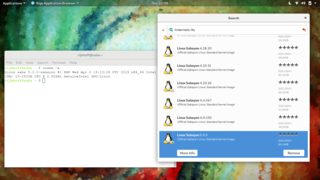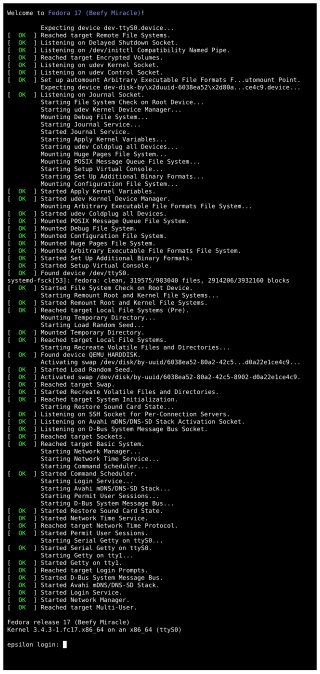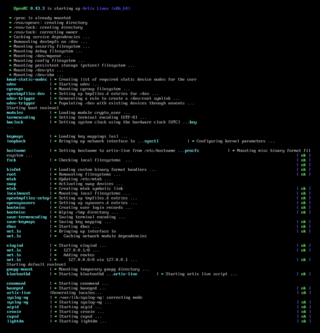This article needs additional citations for verification .(March 2020) |
This is a list of Gentoo Linux derivatives.

This article needs additional citations for verification .(March 2020) |
This is a list of Gentoo Linux derivatives.

| Developer | Indy |
|---|---|
| OS family | Unix-like |
| Working state | Active |
| Source model | Open source |
| Kernel type | Monolithic (Linux) |
| License | Same as Gentoo Linux |
| Official website | fireballiso.sourceforge.net |
FireballISO (or "Fireball") is a VMware virtual appliance that builds a security-hardened Live CD containing a stripped-down custom version of Gentoo Linux. The original intent of the project is focused on providing firewall and networking services to a network, but the appliance can be customized in almost limitless ways to build bootable ISOs that can do many different things. When burned to a CD-ROM, it will allow a perhaps otherwise unused, old computer to boot it and act as a network security device. It may also be used in a virtual environment as a secure cloud appliance. Notable features in the generated ISO include:
The virtual appliance can be updated just like a normal Gentoo system, allowing new Live CD images to be generated with the latest security fixes, bug corrections, additional features, and updated configurations. The Live CD should be re-generated as often as important changes are released by the authors of the various software packages it contains.
| Developer | Daniel Robbins, Oleg Vinichenko, Funtoo Technologies |
|---|---|
| OS family | Linux (based on Gentoo Linux) |
| Working state | Current |
| Source model | Open source |
| Initial release | 2008 |
| Latest release | Rolling release / 1.4 |
| Update method | Emerge |
| Package manager | Portage |
| Platforms | ARM, IA-32, x86-64 |
| Kernel type | Monolithic (Linux) |
| Userland | GNU |
| Default user interface | Gnome, KDE Plasma, XFCE |
| License | Free software and others licenses |
| Preceded by | 1.3 |
| Official website | www |
Funtoo Linux( /fʌntuː/ fun-too) is a Linux distribution based on Gentoo Linux, created by Daniel Robbins (the founder and former project leader of Gentoo Linux) in 2008. It's developed by a core team of developers, and built around a basic vision of improving the core technologies previously used by Gentoo Linux. [1] [2]
In early 2008, Robbins proposed to resolve [3] the Gentoo Foundation problems. [4] But he had left the project in 2004, and his offer was refused. [5] The Funtoo project was born as an initiative to implement his vision, with aims to share innovations. [6]
Funtoo is a source based Linux distribution.
Funtoo features in addition to native UTF-8 by default include:
In July 2017 Funtoo switched from plain portage approach to splitting the portage tree into kits. [7] This should tie software updates together and help with the dependency problems of a rolling release distribution. Kits also are gaining maturity status as they are tested and as patches are applied.
Funtoo uses Git to store the Portage tree. The tree is split into kits now with meta-repo [8] being the repo holding all the kits as submodules.
Metro [9] is an automatable software package for building stages used in installing Funtoo.
boot-update [10] provides a unified mechanism for configuring the GNU GRUB2 and GRUB Legacy boot loader versions.
Funtoo has its own core networking solution to allow users to simplify the creation of complex network interfaces based on pre-created profiles. [11]
Since May 2015 Funtoo offers a pre-built generic kernel with stage3. [12] Although Funtoo is a source-based distribution, it should be possible to use a prebuilt Linux kernel. [13] Funtoo no longer encourages the use of the Sabayon kernel; however, with many improvements to Funtoo's design and init process, one should be able to load a binary kernel plus initrd from a preferred distribution hosting a precompiled/preconfigured kernel. Ubuntu's kernel linux-3.2.0-17-generic has been tested and is known to work. This can benefit those who like to avoid building custom kernels. Using a generic kernel from another distribution should be straightforward if using boot-update Archived 2013-08-09 at the Wayback Machine .
There are multitude of users blog posts or discussions about difference between Gentoo and Funtoo. [14] The most marked difference between the two would be no systemd support in Funtoo, but still delivering for example a working Gnome desktop [15] without the systemd need. [16]
| Official website |
|---|
 | |
| Developer | Anthony G. Basile, et al. |
|---|---|
| OS family | Unix-like |
| Working state | Current |
| Source model | Open source |
| Latest release | 20150616 / June 16, 2015 |
| Available in | Multilanguage |
| Package manager | Portage |
| Platforms | IA-32, x86-64 |
| Kernel type | Monolithic |
| Default user interface | GNOME |
| License | Various |
| Official website | tinhat.sourceforge.net |
Tin Hat is a security-focused Linux distribution derived from Hardened Gentoo Linux. It aims to provide a very secure, stable, and fast desktop environment that lives purely in RAM. [17] Tin Hat boots from CD, or optionally from USB flash drive, but it does not mount any file system directly from the boot device. [17] Instead, Tin Hat employs a large SquashFS image from the boot device which expands into tmpfs upon booting. This makes for long boot times, but fast speeds during use.
The central design consideration in Tin Hat is to construct an operating system that can hide data from an attacker even if he has physical access to the computer. [17] Physical access to a computer with unencrypted filesystems does not secure the data and an attacker could easily retrieve the data. Encrypting the filesystem provides protection from such an attack, but many implementations of encryption do not hide the fact that data is encrypted on the filesystem. For example, the LUKS encryption system includes metadata which detail the block cipher and block cipher mode used in encryption. This information does not help the attacker decrypt the filesystem, but it does reveal that it contains encrypted data and not random data. However, Tin Hat stores its filesystem in the RAM, leaving no data in the computer's hard drive. If the user stores any data via a more permanent means than RAM, the encrypted data is indiscernible from random data.
Tin Hat's preferred method of encryption is via loop-aes v3.
Beyond these considerations, Tin Hat has to also protect against more common exploits based on networking or security holes in software. The hardening model chosen is PaX/Grsecurity which is already provided by the Hardened Gentoo project. Hardening of the kernel and the toolchain make most code born exploits less likely. A non-modular compiled kernel further frustrates the insertion of malicious kernel modules. [18]
Hroontoo is a Gentoo based homemade (LiveCd) console distro for linux administrators. It was created in 2010.
| | |
| Developer | Vidalinux Desktop Project |
|---|---|
| OS family | Unix-like |
| Working state | Abandoned (2010) |
| Source model | Open source |
| Kernel type | Monolithic kernel |
| License | Various |
| Official website | os |
VidaLinux (VLOS) was an operating system based on Gentoo Linux. A GNOME-based OS, VidaLinux installs with the Red Hat Anaconda installer. VidaLinux tries to provide most appropriate tools and support for home and office use, such as PPC support and RealPlayer.
As of December 3, 2009, VLOS has been rebuilt with Daniel Robbins' fork of Gentoo Linux called Funtoo. [19]
Vidalinux comes in two different flavors; one can be downloaded, while the other must be purchased. While the downloaded version technically has all the same software packages as the purchased version, the difference is that the purchased version (which can be bought for 25 USD) contains many binaries of often used programs, while the downloaded version forces the user to download ebuilds of these packages and build the binaries themselves, which requires more time.

A Linux distribution is an operating system made from a software collection that includes the Linux kernel and often a package management system. Linux users usually obtain their operating system by downloading one of the Linux distributions, which are available for a wide variety of systems ranging from embedded devices and personal computers to powerful supercomputers.

Gentoo Linux is a Linux distribution built using the Portage package management system. Unlike a binary software distribution, the source code is compiled locally according to the user's preferences and is often optimized for the specific type of computer. Precompiled binaries are available for some packages. Gentoo runs on a wide variety of processors, including x86, PowerPC, SPARC, DEC Alpha, ARM, MIPS and PA-RISC.

Knoppix, stylized KNOPPIX, is an operating system based on Debian designed to be run directly from a CD / DVD or a USB flash drive. It was first released in 2000 by German Linux consultant Klaus Knopper, and was one of the first popular live distributions. Knoppix is loaded from the removable medium and decompressed into a RAM drive. The decompression is transparent and on-the-fly.

A live CD is a complete bootable computer installation including operating system which runs directly from a CD-ROM or similar storage device into a computer's memory, rather than loading from a hard disk drive. A live CD allows users to run an operating system for any purpose without installing it or making any changes to the computer's configuration. Live CDs can run on a computer without secondary storage, such as a hard disk drive, or with a corrupted hard disk drive or file system, allowing data recovery.

PCLinuxOS, often shortened to PCLOS, is a rolling release Linux distribution for x86-64 computers, with KDE Plasma, MATE, and XFCE as its default user interfaces. It is a primarily FOSS operating system for personal computers aimed at ease of use.
udev is a device manager for the Linux kernel. As the successor of devfsd and hotplug, udev primarily manages device nodes in the /dev directory. At the same time, udev also handles all user space events raised when hardware devices are added into the system or removed from it, including firmware loading as required by certain devices.

Finnix is a Debian-based Live CD operating system, developed by Ryan Finnie and intended for system administrators for tasks such as filesystem recovery, network monitoring and OS installation. Finnix is a relatively small distribution, with an ISO download size of approximately 100 MiB, and is available for the x86 and PowerPC architectures, and paravirtualized systems. Finnix can be run off a bootable CD, a USB flash drive, a hard drive, or network boot (PXE).

Sabayon Linux or Sabayon, was an Italian Gentoo-based Linux distribution created by Fabio Erculiani and the Sabayon development team. Sabayon followed the "out of the box" philosophy, aiming to give the user a wide number of applications ready to use and a self-configured operating system.
The Linux booting process involves multiple stages and is in many ways similar to the BSD and other Unix-style boot processes, from which it derives. Although the Linux booting process depend very much on the computer architecture, those architectures share similar stages and software components, including system startup, bootloader execution, loading and startup of a Linux kernel image, and execution of various startup scripts and daemons. Those are grouped into 4 steps: system startup, bootloader stage, kernel stage, and init process. When a Linux system is powered up or reset, its processor will execute a specific firmware/program for system initialization, such as Power-on self-test, invoking the reset vector to start a program at a known address in flash/ROM, then load the bootloader into RAM for later execution. In personal computer (PC), not only limited to Linux-distro PC, this firmware/program is called BIOS, which is stored in the mainboard. In embedded Linux system, this firmware/program is called boot ROM. After being loaded into RAM, bootloader will execute to load the second-stage bootloader. The second-stage bootloader will load the kernel image into memory, decompress and initialize it then pass control to this kernel image. Second-stage bootloader also performs several operation on the system such as system hardware check, mounting the root device, loading the necessary kernel modules,... Finally, the very first user-space process starts, and other high-level system initializations are performed.
dm-crypt is a transparent block device encryption subsystem in Linux kernel versions 2.6 and later and in DragonFly BSD. It is part of the device mapper (dm) infrastructure, and uses cryptographic routines from the kernel's Crypto API. Unlike its predecessor cryptoloop, dm-crypt was designed to support advanced modes of operation, such as XTS, LRW and ESSIV, in order to avoid watermarking attacks. In addition to that, dm-crypt addresses some reliability problems of cryptoloop.
GVfs is GNOME's userspace virtual filesystem designed to work with the I/O abstraction of GIO, a library available in GLib since version 2.15.1. It installs several modules that are automatically used by applications using the APIs of libgio. There is also FUSE support that allows applications not using GIO to access the GVfs filesystems.
xB Machine is a discontinued virtual operating system that is small enough to fit on a USB drive. The last version seems to have been 0.9.1.5 in mid-2008. It brought a secure computing environment that anonymized all internet activity, and had portable encrypted file storage. It had been developed and offered by XeroBank and based on a modified Gentoo Linux distribution. It could be executed as a virtual machine through a QEMU hypervisor, VMWare, VirtualBox, and any other major virtualization system. It could also be booted from on USB or burned to CD for booting. Virtualization, along with the native implementation of a Tor onion routing for internet connectivity and other encryption and privacy tools, had been utilized to increase the security and anonymity of the user. The developers claimed that it is the most secure operating system in the world and that the technology involved is highly resistant to hacking and spying, even in the most hostile environments. The details and transactions inside each xB Machine account were protected with 256-bit AES encryption. The software also had a self-destruct sequence for eliminating any traces that a user may have left behind on the drivespace after using xB Machine. Meanwhile, Xerobank offers a modular package with xB Browser, xB Mail, and xB VPN, parts of it running only for customers of the bank.
An Amazon Machine Image (AMI) is a special type of virtual appliance that is used to create a virtual machine within the Amazon Elastic Compute Cloud ("EC2"). It serves as the basic unit of deployment for services delivered using EC2.

Calculate Linux is a Linux distribution optimized for fast deployment in an organization environment. It is based on the Gentoo Linux project and includes many preconfigured functions.

systemd is a software suite that provides an array of system components for Linux operating systems. The main aim is to unify service configuration and behavior across Linux distributions. Its primary component is a "system and service manager" – an init system used to bootstrap user space and manage user processes. It also provides replacements for various daemons and utilities, including device management, login management, network connection management, and event logging. The name systemd adheres to the Unix convention of naming daemons by appending the letter d. It also plays on the term "System D", which refers to a person's ability to adapt quickly and improvise to solve problems.
Alpine Linux is a Linux distribution designed to be small, simple, and secure. It uses musl, BusyBox, and OpenRC instead of the more commonly used glibc, GNU Core Utilities, and systemd. This makes Alpine one of few Linux distributions not to be based on the GNU Core Utilities.

Pentoo is a Live CD and Live USB designed for penetration testing and security assessment. Based on Gentoo Linux, Pentoo is provided both as 32 and 64-bit installable live CD. Pentoo is also available as an overlay for an existing Gentoo installation. It features packet injection patched Wi-Fi drivers, GPGPU cracking software, and many tools for penetration testing and security assessment. The Pentoo kernel includes grsecurity and PAX hardening and extra patches - with binaries compiled from a hardened toolchain with the latest nightly versions of some tools available.

OpenRC is a dependency-based init system for Unix-like computer operating systems. It was created by Roy Marples, a NetBSD developer who was also active in the Gentoo project. It became more broadly adopted as an init system outside of Gentoo following the decision by some Linux distributions not to adopt systemd.